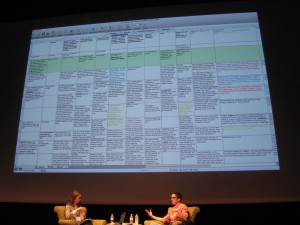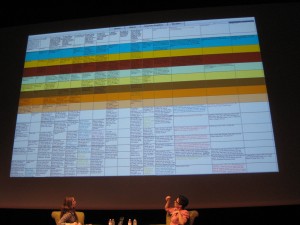
The AIDS Coalition to Unleash Power protests in New York City against the bill. Wikipedia entry.
Last year, Uganda passed a law criminalizing homosexuality, which was ultimately invalidated by the nation’s top court, but for a span of almost a year consenting adults who engaged in homosexual sex might be punished with life in prison and anyone who was found to be counseling gay people would have faced 7 years in prison. Here is the Wikipedia article describing the law. The day after the law was passed, one of the Ugandan tabloids published “EXPOSED! Uganda’s 200 Top Homos Named,” which seemed to be a provocation not only for the police but for vigilantes to go after the people identified.
Some American pastors served as consultants for the nation of Uganda in drafting this bill, including Scott Lively, an anti-gay activist best known for his book The Pink Swastika, which has been thoroughly discredited by historians but that blames the Holocaust on homosexuals. Lively’s organization has been officially designated by the Southern Poverty Law Center as a hate group. Lively was interviewed by NPR’s Michele Martin on 2/27/14 about the Ugandan law and gay rights. The first part of the story may or may not be interesting to think about, but the reason I’m linking you to this interview is the ending. Lively says that perhaps the Ugandan law is a tiny bit extreme, and proposes his own best case scenario for how homosexuality should be handled in the US, to return to the times before the Stonewall Riots Alison Bechdel describes in chapter 4. Lively says:
Well, I believe that societies of the world have an affirmative duty to protect the natural family and to discourage all sex outside of marriage. And I’m talking about adultery, fornication, homosexuality, incest, all of it. But I also believe that in our societies we should have, you know, reasonable tolerance for people who decide to live outside the mainstream discreetly. I think we had a pretty good balance in the 1940s and ’50s in this country. Unquestionably, it was a family-centered mainstream culture and subcultures in which homosexuals and others could live out their lives and be happy.
There’s also an article from last year about the South Carolina legislature punishing the College of Charleston for including Fun Home on a list of recommended reading over the summer. One legislator in South Carolina said that it is inappropriate to have open discussion in college classrooms about homosexuality–that such topics are not worthy of scholarly attention. Bechdel is quoted as replying, in part, that “It’s sad and absurd that the College of Charleston is facing a funding cut for teaching my book – a book which is after all about the toll that this sort of small-mindedness takes on people’s lives.”
It might be useful for you to think about these questions as you develop your maps of Fun Home.
- What does Bechdel mean when she asserts that Fun Home is about “the toll that this sort of small-mindedness takes on people’s lives”?
- If Lively got his wish and we returned to the 1950s when gay people kept their sexuality “discreet” and hidden from the outside world, then would everyone get to “live out their lives and be happy,” as he asserts?
- Based on what we’ve read of Bechdel’s book, what sorts of impacts might such a cultural and legal turning back have?




